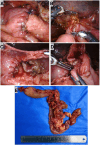Case Report: Robotic pylorus-preserving pancreatoduodenectomy for periampullary rhabdomyosarcoma in a 3-year-old patient
- PMID: 38440415
- PMCID: PMC10910038
- DOI: 10.3389/fsurg.2024.1284257
Case Report: Robotic pylorus-preserving pancreatoduodenectomy for periampullary rhabdomyosarcoma in a 3-year-old patient
Abstract
Periampullary neoplasm is rare in pediatric patients and has constituted a strict indication for pancreatoduodenectomy (PD), which is a procedure sporadically reported in the literature among children. Robotic PD has been routinely performed for periampullary neoplasm in periampullary neoplasm, but only a few cases in pediatric patients have been reported. Here, we report the case of a 3-year-old patient with periampullary rhabdomyosarcoma treated with robotic pylorus-preserving PD and share our experience with this procedure in pediatric patients. A 3-year-old patient presented with obstructive jaundice and a mass in the pancreatic head revealed by imaging. A laparoscopic biopsy was performed. Jaundice progressed with abdominal pain and elevated alpha-amylase leading to urgent robotic exploration in which a periampullary neoplasm was revealed and pathologically diagnosed as rhabdomyosarcoma by frozen section examination. After pylorus-preserving PD, we performed a conventional jejunal loop following a child reconstruction, including an end-to-end pancreaticojejunostomy, followed by end-to-side hepaticojejunostomy and duodenojejunostomy. Delayed gastric emptying (DGE) presented with increasing drain from the nasogastric tube (NGT) a week after the surgery and improved spontaneously within 10 days. In a 13-month follow-up until the present, our case patient recovered well without potentially fatal complications, such as pancreatic fistula. Robotic PD in pediatric patients was safe and effective without intra- or postoperative complications.
Keywords: case report; child; periampullary neoplasm; rhabdomyosarcoma; robotic pancreatoduodenectomy.
© 2024 Liang, Lan, Xu, Liu, Tao, Wang and Zeng.
Conflict of interest statement
The authors declare that the research was conducted in the absence of any commercial or financial relationships that could be construed as a potential conflict of interest.
Figures




Similar articles
-
Laparoscopic pylorus-preserving pancreatoduodenectomy with double jejunal loop reconstruction: an old trick for a new dog.J Laparoendosc Adv Surg Tech A. 2013 Feb;23(2):146-9. doi: 10.1089/lap.2012.0338. Epub 2012 Nov 16. J Laparoendosc Adv Surg Tech A. 2013. PMID: 23157325
-
Robotic pancreatoduodenectomy for a solid pseudopapillary tumor in a ten-year-old child.Surg Oncol. 2018 Dec;27(4):635-636. doi: 10.1016/j.suronc.2018.07.013. Epub 2018 Jul 25. Surg Oncol. 2018. PMID: 30449484
-
Prevention of delayed gastric emptying after pylorus-preserving pancreatoduodenectomy with antecolic reconstruction, a long jejunal loop, and a jejuno-jejunostomy.J Gastrointest Surg. 2014 Apr;18(4):662-73. doi: 10.1007/s11605-013-2446-4. Epub 2014 Feb 20. J Gastrointest Surg. 2014. PMID: 24553874
-
Analysis of clinical trials evaluating complications after pancreaticoduodenectomy: a new era of pancreatic surgery.Surg Today. 2010 Nov;40(11):1011-7. doi: 10.1007/s00595-009-4245-9. Epub 2010 Nov 3. Surg Today. 2010. PMID: 21046497 Review.
-
The impact of pylorus-preserving pancreatoduodenectomy on surgical treatment for cancer of the pancreatic head.J Hepatobiliary Pancreat Surg. 2002;9(2):223-32. doi: 10.1007/s005340200023. J Hepatobiliary Pancreat Surg. 2002. PMID: 12140611 Review.
References
-
- Traverso LW, Longmire WP, Jr. Preservation of the pylorus in pancreaticoduodenectomy. Surg Gynecol Obstet. (1978) 146:959–62. - PubMed
Publication types
LinkOut - more resources
Full Text Sources

